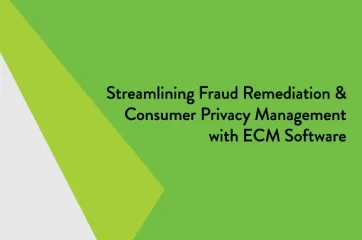Loan Tickler Software
Loan tickler software is used to track customer, member and account documentation, trailing items, and ongoing due diligence. This type of software can be used in both retail and commercial banking, as both types have situations where initial and ongoing items must be collected and monitored.
Common Use Cases for Loan Tickler Software
A new automobile loan, for example, requires signatures, proof of insurance, and receipt of the title by the financial institution. In this case, loan tickler software might trigger a notification to the correct department to follow up on any outstanding documentation. In another case, a bank or credit union may use tickler software to manage annual verifications that insurance and taxes are paid by customers on residential mortgages.
Tickler software is especially helpful on the commercial side for remembering to perform collateral inspections or following up with customers and members to request annual financials and tax returns. Commercial credit and loan tracking requires a significant amount of documentation and ongoing tracking.
Although used primarily by loan departments at financial institutions, tickler software can create smoother processes in other divisions as well. Any department that needs to track and follow up on customers, members and accounts could benefit from it, including deposit and trust departments.
Spreadsheets vs. Loan Tickler Software
Although some banks and credit unions still use a spreadsheet as a tickler, this method is not ideal. Employees can get distracted and forget to either add (or delete an element) on the spreadsheet. Likewise, failing to manually run an exception report (or running an errant report) can lead to stale or unreliable data, thereby exposing the bank to unnecessary risk and, potentially, unwelcome compliance issues.
Automated loan tickler software reduces the human-error element. To be most efficient and cost-effective, a bank or credit union should choose one tickler platform that can be adapted and used by many departments across the institution—including all its branches—as opposed to investing in separate software for various departments or locations.
Loan tickler software streamlines inefficient workflows across the bank or credit union by automatically routing exception reports to those employees who are responsible for obtaining missing signatures, information, or documents. In short, tickler software reduces administrative work and virtually eliminates the potential for error.
What to Look for in Loan Tickler Software
Best-in-class loan tickler software aligns closely with your document imaging process, allowing information to be instantly available to multiple employees both within a location and among its branches. As new documents are scanned in by staff, exceptions should be automatically cleared.
Ideally, your loan tickler software should also offer the flexibility to handle all your tracking needs via custom exceptions and reporting. Automated notice letter generation is also a nice feature to look for.
Most importantly, loan tickler software should save your back-office staff and lenders time to focus on higher impact priorities.
Document Tracking Resources
For additional information on loan tickler software, be sure to check out our extensive resource library with free document tracking spreadsheets, whitepapers, videos and eBooks. Tired of ticklers? Check out our AccuAccount tracking platform that’s built for bankers like you.
Looking for more banking definitions? Check out our banking definitions page.














